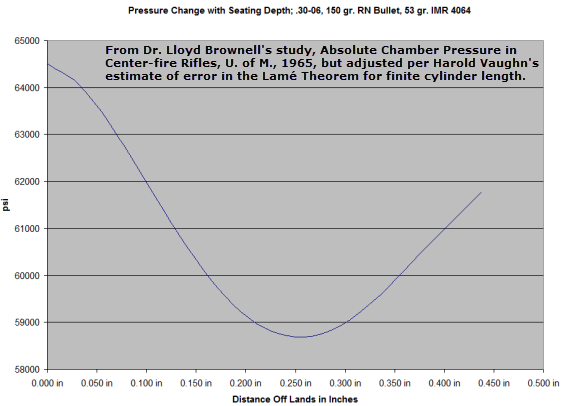RC20
Sorry for the long post, but you are raising a complex issue and I think you might be mixing two concepts.
Seating a bullet out further to increase the COAL does change velocity with a given powder load and trim length for a given bullet because it increases the space available for the gases to expand in the cartridge before the bullet moves out of the neck. As you increase the COAL the velocity drops a bit.
Some rifles get best accuracy with the bullet seated close to the rifling. Most recommend 0.020 to allow some jump. Others claim that their rifles prefer the bullet to be seated right into the rifling to get the best accuracy.
However, when you seat a bullet into the rifling, the instantaneous pressure increases significantly because the bullet has to overcome the resistance of the rifling before it can move and release the pressure there is a spike in PMax. If you are already loading at the max pressure, that might get dangerous.
Using QuickLoad software, I checked the change for an increment increases of COAL for a .308 for different loads of Varget (it is a popular .308 powder choice) with two different bullets in a 24 inch barrel from a relatively light load at around 80% of PMax at SAAMI COAL of 2.800 to just over 100% of PMax at the same COAL.
Interestingly for the Hornady 168 grain AMAX and the Sierra 168 grain SMK, the percentage change per 0.020 increment of COAL was around 0.33% drop in velocity for each increment and the PMax also drops between 1.5 to 1.76% for the Hornady AMAX and 1.47 to 1.68% for the Sierra SMK.
Also, because the bullets are different lengths and shapes, for the same seating depth of 2.800, the SAAMI recommended COAL in all the manuals, the Hornady PMAX was 45.2 grains of Varget at 100.3% of PMax and the Sierra SMK was 46.1 grains of Varget at 100.1% of PMax.
The choice of bullet does make a difference so you really have to check for every bullet and powder combination you use.
Before you do any testing with extended COAL seating, I would recommend that you check your chamber depth. I have two rifles that are great shooters that came from the factory with very tight chambers and a SAAMI COAL was almost touching the rifling. I have others that have a 0.090 jump if the bullet is seated at SAMMI COAL. However, all of my rifles seem to shoot best with at least a 0.020 jump. Some of them shoot as accurately with a 0.080 jump as with a 0.020 jump. The velocity and the powder as well as the bullet weight and bullet shape make much more of a difference than COAL. I only start to play with COAL after I have found what bullet weight and shape shoots best in a particular rifle. The length of the bullet body touching the rifling seems to make an enormous difference in accuracy for some of my rifles. For example, I have one .308 Savage that shoots heavier bullets most accurately. It loves 175 SMKs and TMKs, as well as 190 and 200 SMKs. It hates 180 SMKs. The reason is the bullet shape of the 180 has less bullet touching the rifling and the rifle doesn't shoot that particular bullet well.
I have another Savage .308 that loves 150 SMKs, 155 TMKs and 168 SMKs and TMKs more than 175 SMKs and TMKs. It is the same length barrel and is supposedly an identical barrel. The particular barrel does make a difference so I would recommend that you check your rifle's preferences before you waste your time with COAL variations. That is the tuning step after you get into the right combination of powder, bullet weight, bullet shape and velocity for your particular barrel.

